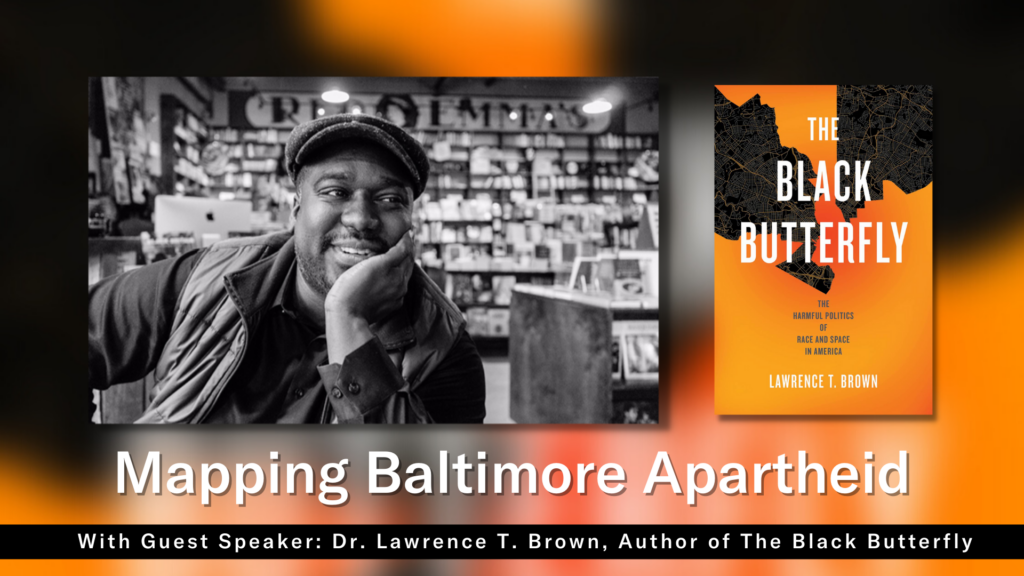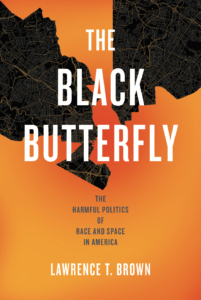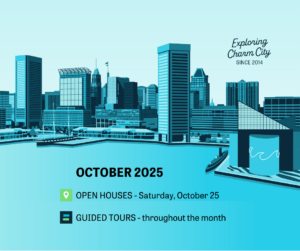The Black Butterfly: The Harmful Politics of Race and Space in America | By: Lawrence T. Brown
Johns Hopkins University Press | 368 pages, with illustrations
Reviewed by Greg Andoll, Assoc. AIA, NOMA
In light of the recent Black Lives Matter protests in Baltimore and across the country, some concerned White friends and colleagues asked me what they can do. My response ranged from join a protest to write a letter to your representatives to donate to a HBCU. However, the most salient advice I can give to anyone concerned about race relations in America is to be woke.
“Woke”’ is increasingly used as a byword for social awareness.
Laurence T. Brown’s The Black Butterfly: The Harmful Politics of Race and Space in America offers such social awareness. Using Baltimore as an example, he examines past and current policies and actions of governments, politicians, private companies, individuals, and institutions through the unique lens of spatial racism.
The Black Butterfly begins by describing the deep racial divide we now experience as a nation. Dr. Brown then lays the historical underpinnings for such hypersegregation. In The “Negro Invasion” (Track 3), he focuses on Baltimore’s infamous history of spatial apartheid and explains how these historical prejudices remain alive today. In perhaps the most engaging chapter, Black Neighborhood Destruction (Track 5), he chronicles how past and current policies all but guarantee the forced uprooting of African Americans in Baltimore and the deleterious corollaries of severed community ties, broken families and lost wealth. He ends with a plea to Make Black Neighborhoods Matter (Track 6) and concludes with solutions on how to do so in Healing the Black Butterfly (Track 7).
Dr. Brown’s writing style is painterly and well organized. The Black Butterfly refers to the wings of predominantly Black neighborhoods in east and west Baltimore. (See book cover.) He uses “tracks” instead of chapters to divide the book which is a reference to a hurricane analogy he later uses to calibrate the degree of hypersegregation in cities. (Baltimore is a category 5 hurricane.) He also provides a glossary of terms used throughout the book which includes spatial racism, segrenomics and the White L (the predominantly White area of Baltimore that runs along the Charles Street corridor to the Inner Harbor then east to Fells Point.)
Dr. Brown convincingly argues that almost every institution and many individuals, past and present, contributed to the spatial racism we see in Baltimore and elsewhere today. He spares no one. Past Mayors, the media, the Federal government, City agencies, current Black politicians, the Black middle class, neighborhood improvement associations, and influential institutions. For example, on purchase of land to establish Morgan College, Sister I. W. Scholastica of the Archdiocese wrote Mayor James Preston on September 23, 1913:
“My dear Mr. Preston,
Allow me to approach you on a matter of grave moment…the sale of property in Mt. Washington as a site for the Morgan Co-educational College for Negroes. As a gentleman knowing the requirements of society…, we ask you to use your influence with the Trustees that their decision on this subject may be changed…to avoid this threatening danger…”. (Emphasis added.)
Mayor Preston responds:
“My dear Sister Scholastica:—
…Anything in the world I can do to help you in this or any other matter
I shall gladly do….”
Another Mayor (McKeldin) actually drew up plans to move Black residents out of the city by establishing a “Negro Colony” in Baltimore County.
While it may be easy to dismiss such sentiments as relics of the past, Dr. Brown writes that the same spatial racism persists in current policies and practices. For example, he describes how current tax policies such as TIFS, PILOTS, and BIDS enable gentrification that destroys Black communities and steals wealth. He writes:
“The most glaring example of tax credit inequity was the 2019 property
tax bill sponsored by Councilmember Eric Costello. Council Bill
19-0414 offered a tax credit for owners of “high-performance newly constructed dwellings.” … In the Finance Department’s equity assessment (of the bill), the department wrote incisively:
“Recipients of this tax credit are likely to be higher income compared to the average resident purchasing from the City’s existing housing stock. This suggests that the Credit has a regressive effect whereby marginal home purchasers are subsidizing benefits which accrue to relatively prosperous residents…” …
All but one city council member voted for the bill…Even after a superbly written equity assessment, the Baltimore City Council failed to block a discriminatory tax credit bill and ensure racial and spatial equity would be implemented in the city’s tax policy.”
He also argues that much of Baltimore’s current physical layout embodies inequality. The location of bike shares and Zip cars, green space, and the layout of the light rail all tend to serve the White L while underserving the Black Butterfly. These are but a couple of examples. Dr. Brown laboriously documents how many other aspects of contemporary Baltimore are tinged by spatial racism.
It might be easy for some to dismiss Dr. Brown’s findings, save for the rigorous research evident in The Black Butterfly. Almost one-quarter of the book is devoted to notes, graphs, and appendices. I fact-checked many of the notes and references and can assure the reader that the Black Butterfly stands on firm scholarly grounds. As such we must take his shocking finding seriously: That Baltimore continues to experience deep hyper segregation that is rooted in past practices and perpetuated by current policies and attitudes; and that we tolerate this at our own peril.
In Healing the Black Butterfly (Track 7), Dr. Brown proposes several solutions to undo the status quo. These include allocating generous sums for social and economic programs, reforming the police, and paying reparations. I am of two minds on this. While he should be applauded for offering solutions to the problems so well documented in the Black Butterfly, the solutions are wholly untethered from reality. (The State of Maryland will not issue “desegregation vouchers” to move residents of the Black Butterfly into the White L.) Nonetheless, these solutions have value. While many are unrealistic, a few may stick, if only in augmented form, to counter racial inequity in Baltimore.
However, the best way to counter racial inequity is to raise awareness. This is where The Black Butterfly shines. With clear and succinct writing, buttressed by rigorous research and copious examples, Dr. Brown casts an unflinching light on the problems Baltimore suffers as a hyper segrated city. Only when a critical mass of concerned citizens is made aware of the issues raised in this book, can change begin.
My advice to those who genuinely want to “do something” remains the same. But rest assured that protests will be more passionate, letters will be more informed, and donations will be more meaningful if done while being woke. The Black Butterfly awakens.
Reach The Reviewer:
Greg Andoll can be reached at greg.a.andoll@gmail.com

Don’t forget to join Doors Open Baltimore for Mapping Baltimore Apartheid, a zoom webinar presented by Dr. Lawrence T Brown, author of “The Black Butterfly”. Dr. Brown will put Baltimore under a microscope, looking at the causes of segregation and drawing on extensive research of data and policy. Brown will demonstrate how data visualization can be a tool to distribute resources to communities in need, and speak to the roles of design, planning, and preservation in healing and restoring redlined Black neighborhoods.



